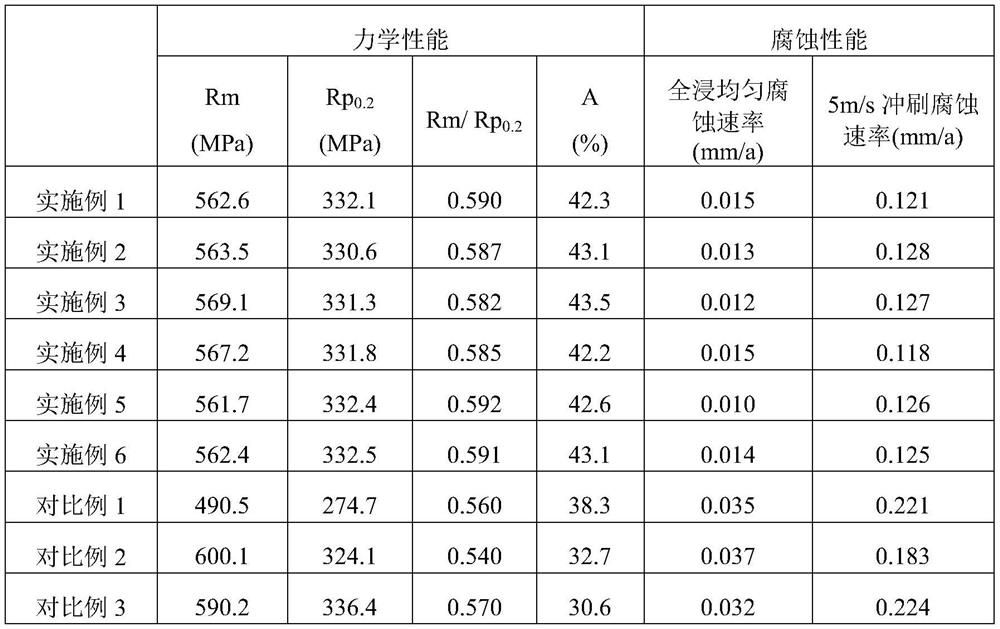High-strength corrosion-resistant copper alloy and preparation method thereof
A copper alloy and corrosion-resistant technology, which is applied in the field of high-strength corrosion-resistant copper alloy and its preparation, can solve the problems of low alloy plasticity, low plasticity, and mechanical properties that only reach tensile strength, and achieve good formability and excellent mechanical properties. The effect of high performance and mechanical properties
- Summary
- Abstract
- Description
- Claims
- Application Information
AI Technical Summary
Problems solved by technology
Method used
Image
Examples
preparation example Construction
[0043] A method for preparing a high-strength corrosion-resistant copper alloy, comprising the following steps:
[0044] (1) Casting: the raw materials are cast into copper alloy ingots by semi-continuous casting, and the casting temperature is 1180-1250°C. The raw materials include: Al 4.0-10.0wt%, Fe 1.0-4.0wt%, Mn 1.0- 4.5wt%, Ni 0.8~3.5wt%, Cr 0.08~0.5wt%, P 0.001~0.05wt%, the sum of unavoidable impurities ≤ 0.15wt%, the balance is Cu;
[0045] (2) heat treatment: the copper alloy ingot prepared in step (1) is subjected to perforated hot extrusion, or hot extrusion, or hot rolling, and the starting temperature of perforated hot extrusion, or hot extrusion, or hot rolling is 850 ~980°C;
[0046] (3) Solid solution: the copper alloy material obtained in step (2) is subjected to solid solution treatment, the solution temperature is 900-1000°C, and the time is 0.5-2h;
[0047] (4) Cold treatment: cold drawing or cold rolling the copper alloy material after solid solution;
...
Embodiment 1
[0053] According to the mass percentage of raw materials: Al 4.0wt%, Fe 4.0wt%, Mn 4.5wt%, Ni 3.5wt%, Cr 0.5wt% and P 0.05wt%, the remaining components are Cu and unavoidable impurities. Melted in a medium frequency induction furnace, cast into diameters by vertical semi-continuous casting method The ingot is cast at a casting temperature of 1180°C; the surface is turned and then cut into The billet is then hot-extruded into a tube billet, the billet heating temperature is 920°C, and the extrusion outlet temperature is 900°C; the tube billet is solidified at 950°C for 1 hour and then drawn into a pipe, and the finished product is annealed after the pipe is straightened. Temperature: 600°C, annealing time 2h.
Embodiment 2
[0055] According to the mass percentage of raw materials: Al 5.0wt%, Fe 3.0wt%, Mn 3.5wt%, Ni 3.5wt%, Cr 0.5wt% and P 0.05wt%, the remaining components are Cu and unavoidable impurities. Melted in a medium frequency induction furnace, cast into a flat ingot with a cross-section of 400mm×160mm by vertical semi-continuous casting method, and the casting temperature is 1200°C. After face milling, it is heated to 950°C in a heating furnace, and after holding for a certain period of time, it is hot-rolled on a hot rolling mill to form a slab; the hot-rolled slab is then subjected to a solid solution at 940°C for 2 hours, then drawn and cold-rolled into a plate, and the plate is straightened. Finished product annealing, annealing temperature: 650°C, annealing time 2h.
PUM
| Property | Measurement | Unit |
|---|---|---|
| microhardness | aaaaa | aaaaa |
| tensile strength | aaaaa | aaaaa |
| yield strength | aaaaa | aaaaa |
Abstract
Description
Claims
Application Information
 Login to View More
Login to View More - R&D
- Intellectual Property
- Life Sciences
- Materials
- Tech Scout
- Unparalleled Data Quality
- Higher Quality Content
- 60% Fewer Hallucinations
Browse by: Latest US Patents, China's latest patents, Technical Efficacy Thesaurus, Application Domain, Technology Topic, Popular Technical Reports.
© 2025 PatSnap. All rights reserved.Legal|Privacy policy|Modern Slavery Act Transparency Statement|Sitemap|About US| Contact US: help@patsnap.com

